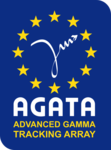Speaker
Description
Neutron-rich oxygen isotopes constitute a perfect playground for testing three-body forces.
For example, the neutron drip line is correctly predicted only when these forces are included in the calculation, as demonstrated by the work of Otsuka et al. [1].
In fact, standard shell model calculations including only two-body forces predict the drip line to be positioned at $N=20$.
The inclusion of three-body forces has the effect of raising the $d_{3/2}$ orbital with the consequence of shifting the drip line from $N=20$ to $N=16$, as observed experimentally.
The importance of three-body forces is now established, however their contribution has yet to be quantified.
For this purpose, the $^{20}$O represents an interesting case of study.
The non-yrast states $2^+_2$ and $3^+_1$ are based on a mixed $(d_{5/2})^3(s_{1/2})^1$ neutron configuration.
Hence, electromagnetic properties of the $2^+_2$ and $3^+_1$ states, such as the excitation energies, the branching ratios and the reduced transition probabilities, provide meaningful information on the position of the $d_{3/2}$ and $s_{1/2}$ orbitals, that are influenced by three-body forces.
An experiment aimed at measuring the lifetime of these states was performed at GANIL (France).
The $^{20}$O was populated via a (d,p) reaction, using a post-accelerated radioactive beam of $^{19}$O provided by the SPIRAL complex and a deuterated polyethylene target deposited on a gold degrader.
The beam-like and target-like partners were detected using the VAMOS spectrometer [2] and the MUGAST array [3], respectively.
The chosen reaction and the MUGAST and VAMOS detectors guaranteed a strong control on the population of the excited states and the capability of eliminating the effect of the feeders.
The $\gamma$ rays emitted by the $^{20}$O were detected by the AGATA array [4] at backward angles.
The lifetimes of the states were measured using the Doppler-Shift Attenuation method by comparing the lineshape of the experimental peaks to realistic Monte Carlo simulations.
In this contribution, the lifetime of the $2^+_2$ and $3^+_1$ states are presented.
[1] T. Otsuka et al., Phys.\ Rev.\ Lett. 105, 032501 (2010).
[2] M. Rejmund et al., Nucl. Instr. and Meth. A 646, 184 (2011).
[3] M. Assiè et al., Nucl. Instr. and Meth. A, 1041, 165743 (2021).
[4] E. Clèment et al., Nucl. Instr. Meth. A 855, 1 (2017).

